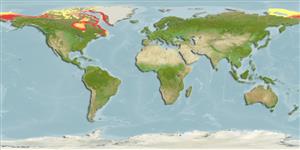Environment: milieu / climate zone / depth range / distribution range
Écologie
marin; saumâtre démersal; profondeur 0 - 280 m (Ref. 117245). Polar; 83°N - 49°N, 142°E - 45°W (Ref. 117245)
Arctic: to James Bay and Straits of Belle Isle in Canada and Greenland.
Taille / Poids / Âge
Maturity: Lm ? range ? - ? cm
Max length : 22.0 cm TL mâle / non sexé; (Ref. 7251)
Épines dorsales (Total): 8 - 9; Rayons mous dorsaux (Total): 14-17; Épines anales 0; Rayons mous anaux: 11 - 13. Caudal fin rounded. Upper parts blackish-brown (paler in females), flanks with dark cross-bands (fainter in males, which have dark bordered white or silvery irregular spots under pectoral fins and above anal fin); breast and belly with dark spots in males and broad white band on reddish orange from pelvic base to anus; lower lip spotted in males (dark in females); pelvic fins with 2-3 dark cross-bands; pectoral rays blackish-brown in males, the membrane with 4-5 transverse rows of translucent spots (some light bands in females); white blotches or stripes on dorsal and anal fins (Ref. 4698).
Found on rocky bottoms among algae (Ref. 4698). Benthic (Ref. 58426). Feeds on small benthic amphipods (Ref. 4698).
Life cycle and mating behavior
Maturité | Reproduction | Frai | Œufs | Fécondité | Larves
Robins, C.R. and G.C. Ray, 1986. A field guide to Atlantic coast fishes of North America. Houghton Mifflin Company, Boston, U.S.A. 354 p. (Ref. 7251)
Statut dans la liste rouge de l'IUCN (Ref. 130435)
Menace pour l'homme
Harmless
Utilisations par l'homme
Plus d'informations
RéférencesAquacultureProfil d'aquacultureSouchesGénétiqueElectrophoresesHéritabilitéPathologiesTraitementNutrientsMass conversion
CollaborateursImagesStamps, Coins Misc.SonsCiguateraVitesseType de nageSurface branchialeOtolithesCerveauxVision
Outils
Articles particuliers
Télécharger en XML
Sources Internet
Estimates based on models
Preferred temperature (Ref.
123201): 0.1 - 7.8, mean 1.1 °C (based on 532 cells).
Phylogenetic diversity index (Ref.
82804): PD
50 = 0.5000 [Uniqueness, from 0.5 = low to 2.0 = high].
Bayesian length-weight: a=0.00676 (0.00300 - 0.01523), b=3.17 (2.98 - 3.36), in cm total length, based on LWR estimates for this (Sub)family-body shape (Ref.
93245).
Niveau trophique (Ref.
69278): 3.4 ±0.52 se; based on food items.
Résilience (Ref.
120179): Milieu, temps minimum de doublement de population : 1,4 à 4,4 années (Preliminary K or Fecundity.).
Fishing Vulnerability (Ref.
59153): Low vulnerability (12 of 100).
